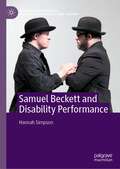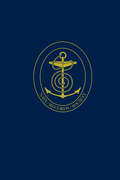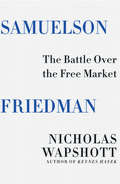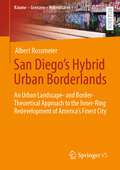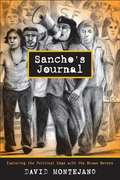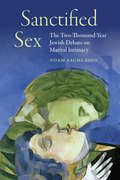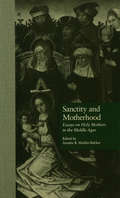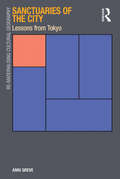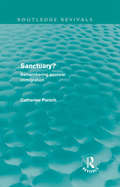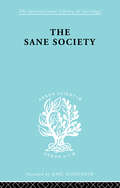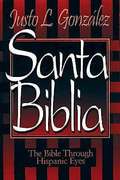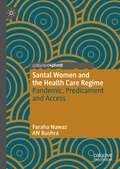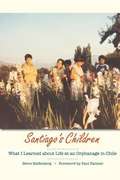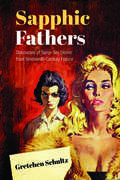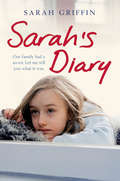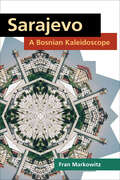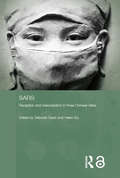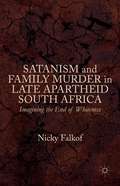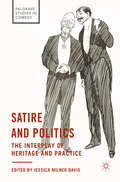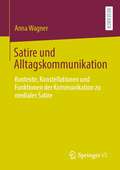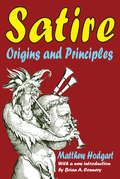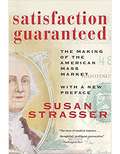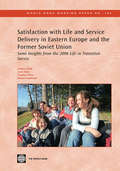- Table View
- List View
Samuel Beckett and Disability Performance (New Interpretations of Beckett in the Twenty-First Century)
by Hannah SimpsonBeckett’s plays have attracted a striking range of disability performances – that is, performances that cast disabled actors, regardless of whether their roles are explicitly described as ‘disabled’ in the text. Grounded in the history of disability performance of Beckett’s work and a new theorising of Beckett’s treatment of the impaired body, Samuel Beckett and Disability Performance examines four contemporary disability performances of Beckett’s plays, staged in the UK and US, and brings the rich fields of Beckett studies and disability studies into mutually illuminating conversation. Pairing original interviews with the actors and directors involved in these productions alongside critical analysis underpinned by recent disability and performance theory, this book explores how these productions emphasise or rework previously undetected indicators of disability in Beckett’s work. More broadly, it reveals how Beckett’s theatre compulsively interrogates alternative embodiments, unexpected forms of agency, and the extraordinary social interdependency of the human body.
Samuel Pepys and the Second Dutch War: Pepys's Navy White Book and Brooke House Papers
by Pepys SamuelThe two pieces of work which make up this volume were compiled by Pepys in the 1660s. The first is Pepys’s own record of how the Navy Board functioned. It records details of meetings with fellow officers such as Sir William Penn and Sir John Mennes, and how work could be hampered at times by the refusal of an officer to sign a contract or bill as he had not been present at the original discussions.The Navy White Book gives the discussions which took place over a variety of matters, such as, contracts with Sir William Warren, a timber merchant; costs and quality of masts and canvas.The Brooke House Papers deal with the inquiry set up by the House of Commons into the conduct of the Second Dutch War, following the humiliation of the Dutch invasion of 1667, and the inefficiency of the Navy Board. The Brooke House Papers further show Pepys defending the Navy Board’s professionalism and integrity, and also that naval administration during the Second Dutch War was efficient. The Papers also show Charles II ‘s role in protecting the Navy Board, by making his dissatisfaction with the inquiry known, through his disrespectful language and interruptions, as well as his support for Pepys, whom he makes the Board’s spokesman.
Samuelson Friedman: The Battle Over The Free Market
by Nicholas WapshottFrom the author of Keynes Hayek, the next great duel in the history of economics. In 1966 two columnists joined Newsweek magazine. Their assignment: debate the world of business and economics. Paul Samuelson was a towering figure in Keynesian economics, which supported the management of the economy along lines prescribed by John Maynard Keynes’s General Theory. Milton Friedman, little known at that time outside of conservative academic circles, championed “monetarism” and insisted the Federal Reserve maintain tight control over the amount of money circulating in the economy. In Samuelson Friedman, author and journalist Nicholas Wapshott brings narrative verve and puckish charm to the story of these two giants of modern economics, their braided lives and colossal intellectual battles. Samuelson, a forbidding technical genius, grew up a child of relative privilege and went on to revolutionize macroeconomics. He wrote the best-selling economics textbook of all time, famously remarking "I don’t care who writes a nation’s laws—or crafts its advanced treatises—if I can write its economics textbooks." His friend and adversary for decades, Milton Friedman, studied the Great Depression and with Anna Schwartz wrote the seminal books The Great Contraction and A Monetary History of the United States. Like Friedrich Hayek before him, Friedman found fortune writing a treatise, Capitalism and Freedom, that yoked free markets and libertarian politics in a potent argument that remains a lodestar for economic conservatives today. In Wapshott’s nimble hands, Samuelson and Friedman’s decades-long argument over how—or whether—to manage the economy becomes a window onto one of the longest periods of economic turmoil in the United States. As the soaring economy of the 1950s gave way to decades stalked by declining prosperity and "stagflation," it was a time when the theory and practice of economics became the preoccupation of politicians and the focus of national debate. It is an argument that continues today.
San Diego's Hybrid Urban Borderlands: An Urban Landscape- and Border-Theoretical Approach to the Inner-Ring Redevelopment of America’s Finest City (Räume – Grenzen – Hybriditäten)
by Albert RossmeierThis study aims for a wider understanding of the redevelopment processes that emerged several decades ago in downtown San Diego and now gradually spread over the downtown edges into the inner ring. Perspectively situated in the fields of urban landscape and urban border studies, the research project outlines how the eastward ‘redevelopment wave’ in San Diego contests socialized neighborhood (boundary) perceptions by transforming the former first-tier suburbs from disinvested communities into ‘urban villages’ and trendy places to be. The study shows how the redevelopment perforates, dissolves, and shifts socialized, linear neighborhood boundaries into areas that are simultaneously part of the one and the other neighborhood. In the present work, the resulting, rather undefined or stretched border areas have been referred to as hybrid urban borderlands. This notion is a novel conceptual approach that can be deemed a promising lens for future studies on neighborhood change, urban redevelopment, and socio-spatial re-interpretation beyond the context of San Diego.
San Francisco Year Zero: Political Upheaval, Punk Rock and a Third-Place Baseball Team
by Lincoln A. MitchellSan Francisco is a city of contradictions. It is one of the most socially liberal cities in America, but it also has some of the nation’s worst income inequality. It is a playground for tech millionaires, with an outrageously high cost of living, yet it also supports vibrant alternative and avant-garde scenes. So how did the city get this way? In San Francisco Year Zero, San Francisco native Lincoln Mitchell traces the roots of the current situation back to 1978, when three key events occurred: the assassination of George Moscone and Harvey Milk occurring fewer than two weeks after the massacre of Peoples Temple members in Jonestown, Guyana, the explosion of the city’s punk rock scene, and a breakthrough season for the San Francisco Giants. Through these three strands, Mitchell explores the rifts between the city’s pro-business and progressive-left politicians, the emergence of Dianne Feinstein as a political powerhouse, the increasing prominence of the city’s LGBT community, punk’s reinvigoration of the Bay Area’s radical cultural politics, and the ways that the Giants helped unify one of the most ethnically and culturally diverse cities in the nation. Written from a unique insider’s perspective, San Francisco Year Zero deftly weaves together the personal and the political, putting a human face on the social upheavals that transformed a city.
Sana tus raíces ancestrales: Libera los patrones familiares que te frenan
by Anuradha Dayal-Gulati• Explora los principios que gobiernan tu campo energético familiar y las formas en que este campo ancestral puede apoyarte o mantenerte cautivo• Proporciona ejercicios y herramientas para ayudarte a reconocer y liberar patrones familiares negativos y sanar traumas ancestrales• Analiza la importancia de honrar a tus antepasados, comparte sugerencias sobre la creación de altares, oraciones y el ritual védico de TarpanamMuchas personas se sienten estancadas, incapaces de alcanzar sus objetivos. Los mismos problemas siguen apareciendo en el trabajo y en las relaciones por mucho que intenten hacer cambios y superar obstáculos. ¿Qué pasaría si los patrones que se repiten en tu vida y en tus relaciones no se originaran en ti? La fuente de tus desafíos podría tener sus raíces en un trauma ancestral que pide ser curado. Las experiencias y heridas de tus padres, abuelos y ancestros pueden afectarte; a veces, los temas se repiten en una familia durante varias generaciones —patrones de dificultades financieras, rivalidad entre hermanos, divorcios o, por el contrario, matrimonios largos y felices, buena salud y buen ánimo.Anuradha Dayal-Gulati, practicante de energía especializada en sanación ancestral y emocional, proporciona ejercicios y herramientas —como prácticas de diario, visualizaciones, mapas mentales y el ritual védico de Tarpanam— que pueden ayudarte a reconocer y liberar patrones familiares negativos y mejorar los positivos. Ella comparte su propio viaje de sanación y su experiencia con la terapia de constelaciones familiares, explica cómo honrar a tus antepasados y explora en profundidad el uso de esencias florales para transformar emociones y liberar traumas generacionales.Al enseñarte cómo reconocer los patrones que se manifiestan en tus experiencias diarias, Sana tus raíces ancestrales muestra cómo puedes eliminar las barreras inconscientes e invisibles que te impiden crear la vida que deseas.
Sancho's Journal: Exploring the Political Edge with the Brown Berets
by David MontejanoHow do people acquire political consciousness, and how does that consciousness transform their behavior? This question launched the scholarly career of David Montejano, whose masterful explorations of the Mexican American experience produced the award-winning books Anglos and Mexicans in the Making of Texas, 1836–1986, a sweeping outline of the changing relations between the two peoples, and Quixote’s Soldiers: A Local History of the Chicano Movement, 1966–1981, a concentrated look at how a social movement “from below” began to sweep away the last vestiges of the segregated social-political order in San Antonio and South Texas. Now in Sancho’s Journal, Montejano revisits the experience that set him on his scholarly quest—“hanging out” as a participant-observer with the South Side Berets of San Antonio as the chapter formed in 1974. Sancho’s Journal presents a rich ethnography of daily life among the “batos locos” (crazy guys) as they joined the Brown Berets and became associated with the greater Chicano movement. Montejano describes the motivations that brought young men into the group and shows how they learned to link their individual troubles with the larger issues of social inequality and discrimination that the movement sought to redress. He also recounts his own journey as a scholar who came to realize that, before he could tell this street-level story, he had to understand the larger history of Mexican Americans and their struggle for a place in U. S. society. Sancho’s Journal completes that epic story.
Sanctified Sex: The Two-Thousand-Year Jewish Debate on Marital Intimacy
by Noam Sachs ZionSanctified Sex draws on two thousand years of rabbinic debates addressing competing aspirations for loving intimacy, passionate sexual union, and sanctity in marriage. What can Judaism contribute to our struggles to nurture love relationships? What halakhic precedents are relevant, and how are rulings changing? The rabbis, of course, seldom agree. Underlying their arguments are perennial debates: What kind of marital sex qualifies as ideal—sacred self-control of sexual desire or the holiness found in emotional and erotic intimacy? Is intercourse degrading in its physicality or the highest act of spiritual/mystical union? And should women or men (or both) wield ultimate say about what transpires in bed? Noam Sachs Zion guides us chronologically and steadily through fraught terrain: seminal biblical texts and their Talmudic interpretations; Talmud tales of three unusual rabbis and their marital bedrooms; medieval codifiers and mystical commentators; ultra-Orthodox rabbis clashing with one another over radically divergent ideals; and, finally, contemporary rabbis of varied denominations wrestling with modern transformations in erotic lifestyles and values. Invited into these sanctified and often sexually explicit discussions with our ancestors and contemporaries, we encounter innovative Jewish teachings on marital intimacy, ardent lovemaking techniques, and the art of couple communication vital for matrimonial success.
Sanctity and Motherhood: Essays on Holy Mothers in the Middle Ages (Garland Medieval Casebooks)
by Anneke B. Mulder-BakkerFirst published in 1995. Routledge is an imprint of Taylor & Francis, an informa company.
Sanctuaries of the City: Lessons from Tokyo (Re-materialising Cultural Geography Ser.)
by Anni GreveThis book proposes that we can learn from Tokyo about the instrinsic importance of in-between realms to an international culture: the sanctuaries. It argues that certain urban societies are more robust than others because they offer socio-spatial capacities that enable the development of skills for coping with modern forms of living. It studies places that may open the way to an international culture, namely market places, venues for performing arts and religious sites, which - with particular reference to the Durkheimian tradition - are considered here in their quality as sanctuaries. From its empirical analysis of such sanctuaries in Tokyo, this book develops a more general theory about mega-cities, urban sociability and identity.
Sanctuary?: Remembering postwar immigration (Routledge Revivals)
by Catherine PanichIn the ten years immediately following the Second World War, some 170 000 immigrants from Europe and Britain arrived in Australia. First published in 1988, this unique book recreates the experiences of those who fled a ravaged Europe to seek a new life in far-distant Australia. Their stories are told in the words of the people themselves, supplemented with photographs, documents, press reports and memorabilia. These stories of over 100 Australians, New and Old, stories sometimes humorous and often very moving, provide a fascinating insight into a significant moment in Australian history. As the first definitive examination of life in the migrant camps, it documents a part of Australian history in danger of vanishing without trace. Never before has there been such a collection of intensely personal accounts of what it was like to pass through the immigration centres and workers’ hostels on the way to building new lives – and to shaping present-day Australia.
Sane Society Ils 252 (International Library of Sociology)
by Erich FrommFollowing the publication of the seminal Fear of Freedom, Erich Fromm applied his unique vision to a critique of contemporary capitalism in The Sane Society. Where the former dealt with man's historic inability to come to terms with his sense of isolation, and the dangers to which this can lead, The Sane Society took his theories one step further. In doing so it established Fromm as one of the most controversial political thinkers of his generation. Anaylsing how individuals conform to contemporary capitalist and patriarchal societies, the book was published to wide acclaim and even wider disapproval. It was a scathing indictment of modern capitalism and as such proved unwelcome to many. Unwelcome because much of what Fromm had to say was true. Today, as we settle into the challenges of the 21st century, Fromm's writings are just as relevant as when they were first written. Read it and decide for yourself - are you living in a sane society?
Santa Biblia: The Bible Through Hispanic Eyes
by Justo L. GonzálezGonzález explores how a Hispanic perspective illuminates the biblical text in ways that will be valuable not only for Latino readers but also for the church at large. Introducing five "paradigms" for Latino biblical interpretation, González discusses theory and provides concrete examples of biblical texts that gain new meaning when read from a different perspective.
Santal Women and the Health Care Regime: Pandemic, Predicament and Access
by Faraha Nawaz AN BushraThis book explores the access to healthcare service during a global pandemic by rural ethnic women of Bangladesh. The authors consider different dimensions of accessibility such as- physical access, financial access, health behaviour and different socio-cultural factors of access, and attempts to explore the degree of access to healthcare of rural ethnic women from Santal tribe in Bangladesh during the COVID-19 pandemic. This exploration is likely to be helpful for healthcare providing organizations, international donor agencies, policy makers, and future researchers of gender studies, social policy, development studies among other fields.
Santiago's Children
by Steve ReifenbergUnclear about his future career path, Steve Reifenberg found himself in the early 1980s working at a small orphanage in a poor neighborhood in Santiago, Chile, where a determined single woman was trying to create a stable home for a dozen or so children who had been abandoned or abused. With little more than good intentions and very limited Spanish, the 23-year-old Reifenberg plunged into the life of the Hogar Domingo Savio, becoming a foster father to kids who stretched his capacities for compassion and understanding in ways he never could have imagined back in the United States. In this beautifully written memoir, Reifenberg recalls his two years at the Hogar Domingo Savio. His vivid descriptions create indelible portraits of a dozen remarkable kids--mature-beyond-her-years Verónica; sullen, unresponsive Marcelo; and irrepressible toddler Andrés, among them. As Reifenberg learns more about the children's circumstances, he begins to see the bigger picture of life in Chile at a crucial moment in its history. The early 1980s were a time of economic crisis and political uprising against the brutal military dictatorship of Augusto Pinochet. Reifenberg skillfully interweaves the story of the orphanage with the broader national and international forces that dramatically impact the lives of the kids. By the end of Santiago's Children, Reifenberg has told an engrossing story not only of his own coming-of-age, but also of the courage and resilience of the poorest and most vulnerable residents of Latin America.
Sapphic Fathers
by Gretchen SchultzLiterature that explored female homosexuality flourished in late nineteenth-century France. Poets, novelists, and pornographers, whether Symbolists, Realists, or Decadents, were all part of this literary moment. In Sapphic Fathers, Gretchen Schultz explores how these male writers and their readers took lesbianism as a cipher for apprehensions about sex and gender during a time of social and political upheaval.Tracing this phenomenon through poetry (Baudelaire, Verlaine), erotica and the popular novel (Belot), and literary fiction (Zola, Maupassant, Péladan, Mendès), and into scientific treatises, Schultz demonstrates that the literary discourse on lesbianism became the basis for the scientific and medical understanding of female same-sex desire in France. She also shows that the cumulative impact of this discourse left tangible traces that lasted well beyond nineteenth-century France, persisting into twentieth-century America to become the basis of lesbian pulp fiction after the Second World War.
Sarah's Diary: An unflinchingly honest account of one family's struggle with depression
by Sarah Griffin'I was fourteen when I found my Dad trying to commit suicide in the garage. Sounds shocking doesn't it? But that was part of me, part of living with my Dad'Sarah's Diary is the very personal diary of Sarah Griffin - an ordinary teenage girl learning to deal with the ups and downs of family life. On the outside hers was like any other family, but behind closed doors lay a sad and lonely secret. Sarah's Dad had depression -- a condition we've all heard of but seldom discuss. Beautifully written, brutally honest, Sarah's story is compelling reading.
Sarajevo: A Bosnian Kaleidoscope (Interp Culture New Millennium)
by Fran MarkowitzThis fascinating urban anthropological analysis of Sarajevo and its cultural complexities examines contemporary issues of social divisiveness, pluralism, and intergroup dynamics in the context of national identity and state formation. Rather than seeing Bosnia-Herzegovina as a volatile postsocialist society, the book presents its capital city as a vibrant yet wounded center of multicultural diversity, where citizens live in mutual recognition of difference while asserting a lifestyle that transcends boundaries of ethnicity and religion. It further illuminates how Sarajevans negotiate group identity in the tumultuous context of history, authoritarian rule, and interactions with the built environment and one another. As she navigates the city, Fran Markowitz shares narratives of local citizenry played out against the larger dramas of nation and state building. She shows how Sarajevans' national identities have been forged in the crucible of power, culture, language, and politics. Sarajevo: A Bosnian Kaleidoscope acknowledges this Central European city's dramatic survival from the ravages of civil war as it advances into the present-day global arena.
Sars: Reception and Interpretation in Three Chinese Cities (Routledge Contemporary China Series #Vol. 17)
by Deborah Davis Helen SiuSARS (Acute Respiratory Syndrome) first presented itself to the global medical community as a case of atypical pneumonia in one small Chinese village in November 2002. Three months later the mysterious illness rapidly spread and appeared in Vietnam, Hong Kong, Toronto and then Singapore. The high fatality rate and sheer speed at which this disease spread prompted the World Health Organization to initiate a medieval practice of quarantine in the absence of any scientific knowledge of the disease. Now three years on from the initital outbreak, SARS poses no major threat and has vanished from the global media. Written by a team of contributors from a wide variety of disciplines, this book investigates the rise and subsequent decline of SARS in Hong Kong, mainland China and Taiwan. Multidisciplinary in its approach, SARS explores the epidemic from the perspectives of cultural geography, media studies and popular culture, and raises a number of important issues such as the political fate of the new democracy, spatial governance and spatial security, public health policy making, public culture formation, the role the media play in social crisis, and above all the special relations between the three countries in the context of globalization and crisis. It provides new and profound insights into what is still a highly topical issue in today’s world.
Satanism and Family Murder in Late Apartheid South Africa
by Nicky FalkofIn the last years of apartheid, white South African society found itself in the grip of previously unimaginable social and political change, which sometimes manifested in morbid cultural symptoms. This book considers two of those symptoms, a pair of matched moral panics that appeared in the contemporary media and in popular literature. It argues that excessive reactions to the apparent threat posed by a cult of white Satanists, never proven to exist, and to a so-called epidemic of white family murder reveal important truths about fear, violence and resistance, as well as fragmentations within the poles of white South African identity: nationalism, gender, history, the family, even whiteness itself. Together, the Satanism scare and the family murder 'epidemic' draw a compelling picture of the psychic landscape of white culture at the end of apartheid, revealing both pathological responses to social change and the brutalising effects that apartheid had on those who benefited from itmost.
Satire and Politics: The Interplay of Heritage and Practice (Palgrave Studies in Comedy)
by Jessica Milner DavisThis book examines the multi-media explosion of contemporary political satire. Rooted in 18th century Augustan practice, satire's indelible link with politics underlies today's universal disgust with the ways of elected politicians. This study interrogates the impact of British and American satirical media on political life, with a special focus on political cartoons and the levelling humour of Australasian satirists.
Satire und Alltagskommunikation: Kontexte, Konstellationen und Funktionen der Kommunikation zu medialer Satire
by Anna WagnerAnna Wagner geht in diesem Buch der Frage nach, wie Menschen unter Bedingungen der Digitalisierung über, in und durch mediale Satire kommunizieren. Satire ist mit der Emergenz und Verbreitung digitaler Medien populärer geworden und liegt heute in vielfach ausdifferenzierter medialer Form vor. Gleichzeitig sind auch die Lebenswelten von Menschen mit (digitalen) Medien durchdrungen und die Kommunikation mit anderen durch diese geprägt. Anna Wagner widmet sich im Buch diesen Entwicklungen und plädiert dafür, bei der Analyse der zwischenmenschlichen Kommunikation zu Satire unter Digitalisierungsbedingungen die überdauernden kommunikativen Strukturen und sozialen Beziehungen stärker zu berücksichtigen. Hierzu schlägt sie zur Bearbeitung der Fragestellung eine lebensweltlich-kontextualisierende Perspektive auf das Phänomen vor und erarbeitet das Konzept der Alltagskommunikation mit vier spezifischen Analyselinsen. In zwei empirischen Studien analysiert die Autorin unter Anwendung des Konzepts schließlich die thematisch vielfältige zwischenmenschliche Kommunikation rund um mediale Satire und nimmt dabei die lebensweltlichen Kontexte, kommunikativen Konstellationen und Funktionen der Kommunikation in den Blick.
Satire: Origins and Principles
by Matthew HodgartSatire, according to Jonathan Swift, is a mirror where beholders generally discover everybody's face but their own. and over twenty-four centuries the mirror of satirical literature has taken on many shapes. Yet certain techniques recur continually, certain themes are timeless, and some targets are perennial. Politics (the mismanagement of men by other men) has always been a target of satire, as has the war between sexes.The universality of satire as a mode and creative impulse is demonstrated by the cross-cultural development of lampoon and travesty. Its deep roots and variety are shown by the persistence of allegory, fable, aphorism, and other literary subgenres. Hodgart analyzes satire at some of its most exuberant moments in Western literature, from Aristophanes to Brecht. His analysis is supplemented by a selection and discussion of prints and cartoons.Satire continues to help us make sense of the conventions that seem to have been almost genetically transmitted from their satiric ancestors to our digital contemporaries. This is especially evident in Hodgart's repeated references to satire's predilection for the ephemeral, for camouflaging itself among the everyday, for speaking to the moment, and thus for integrating itself as deeply as possible into society. Brian Connery's new introduction places Hodgart's analysis in its proper place in the development of twentieth-century criticism.
Satisfaction Guaranteed: The Making Of The American Mass Market
by Susan StrasserThis sweeping history provides the reader with a better understanding of America’s consumer society, obsession with shopping, and devotion to brands. Focusing on the advertising campaigns of Coca-Cola, Kellogg’s, Wrigley’s, Gillette, and Kodak, Strasser shows how companies created both national brands and national markets. These new brands eventually displaced generic manufacturers and created a new desire for brand-name goods. The book also details the rise and development of department stores such as Macy’s, grocery store chains such as A&P and Piggly Wiggly, and mail-order companies like Sears Roebuck and Montgomery Ward.
Satisfaction with Life and Service Delivery in Eastern Europe and the Former Soviet Union
by Pradeep K. Mitra Salman Zaidi Asad Alam Ramya SundaramThe past two decades in Eastern Europe and the former Soviet Union have been times of tremendous change, with countries undergoing rapid transformation from centrally-planned to market-oriented economies. While poverty increased during the initial years of transition, primarily on account of the sharp economic contraction, the resurgence of economic growth in the region since 1998 has resulted in a rebound in household incomes and living standards. Data from the 2006 Life in Transition Survey (LiTS)-a joint initiative of the European Bank for Reconstruction and Development and the World Bank-provides a unique opportunity to investigate the extent to which citizens of ECA countries are satisfied with their lives and with the performances of their governments, and to study key factors influencing their outlook in a systematic way across all countries of the region. The main objective of the LiTS was to assess the impact of transition on people, covering four main themes. First, it collected personal information on aspects of material well-being, including household expenditures, possession of consumer goods such as a car or mobile phone, and access to local public services and utilities. Second, the survey included measures of satisfaction and attitudes towards economic and political reforms as well as public service delivery. Third, the LiTS captured individual 'histories'-key events and episodes that may have influenced their attitudes towards reforms, and information on family background, employment, and coping strategies. Finally, the survey also attempted to capture the extent to which crime and corruption are affecting peoples' lives, and the extent to which individuals' trust in other people and in state institutions has changed over time.
